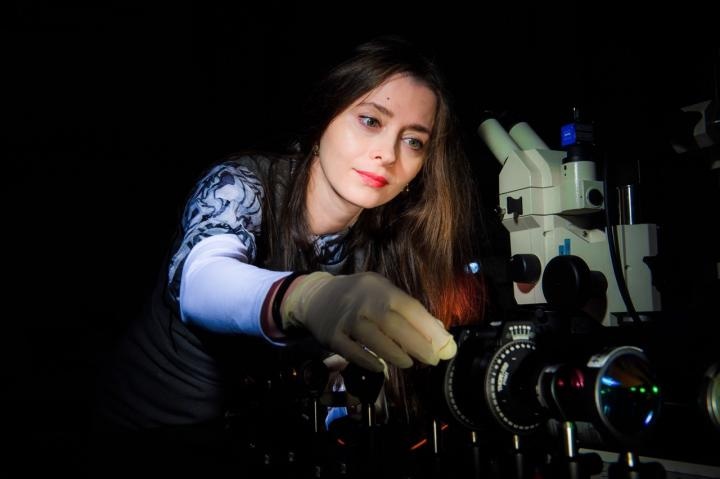Jul 23 2019
Scientists at Ben-Gurion University of the Negev (BGU) have designed a new chip device that provides excellent identification of minuscule blood residues for forensic applications.
 The BGU microfluidic chip not only increases the chemiluminescent intensity several-fold but also prolongs the glow time of luminol, enabling the detection of much smaller blood samples in a forensic scene. The chip device was developed by BGU Prof. Alina Karabchevsky (pictured here), head of BGU’s Light-on-a-Chip Group, a member of the BGU Unit of Electro-Optical Engineering and the Ilse Katz Institute for Nanoscale Science and Technology. (Image caption: Dani Machlis, Ben-Gurion University)
The BGU microfluidic chip not only increases the chemiluminescent intensity several-fold but also prolongs the glow time of luminol, enabling the detection of much smaller blood samples in a forensic scene. The chip device was developed by BGU Prof. Alina Karabchevsky (pictured here), head of BGU’s Light-on-a-Chip Group, a member of the BGU Unit of Electro-Optical Engineering and the Ilse Katz Institute for Nanoscale Science and Technology. (Image caption: Dani Machlis, Ben-Gurion University)
Criminologists detect microscopic blood drops, as well as DNA, proteins, and low hydrogen peroxide concentrations, using luminol. Not all these can be seen by the naked eye but they become visible via a chemical reaction called “chemiluminescence.”
It is economical and beneficial to detect biological residues using this technique as the detected signal is not dependent on an external light source.
Apart from increasing the chemiluminescent intensity several times, the BGU microfluidic chip also increases the glow time of luminol, allowing the detection of much smaller blood samples in a forensic scene.
BGU Professor Alina Karabchevsky, who is the head of BGU’s Light-on-a-Chip Group and a member of the BGU Unit of Electro-Optical Engineering and the Ilse Katz Institute for Nanoscale Science and Technology, designed this chip device.
The innovation integrates the use of luminol with silver or gold nanospheres in a uniquely developed microfluidic device that expands the detection limit by increasing chemiluminescent light emission and enabling imaging in the chip.
“Our findings open the door to new integrated microfluidic chips,” stated Prof. Karabchevsky. “Practical implementation of this discovered effect will include further superior chemiluminescence-based sensors for forensic science, research in biology and chemistry, and no-source opto-chemical lasers.”
Identifying trace quantities of blood can increase the efficiency and accuracy of a forensic investigation of a crime scene but requires more sensitive detectors than those that are currently available. We are looking for partners to further develop this promising patented invention.
Netta Cohen, Chief Executive Officer, BGN Technologies